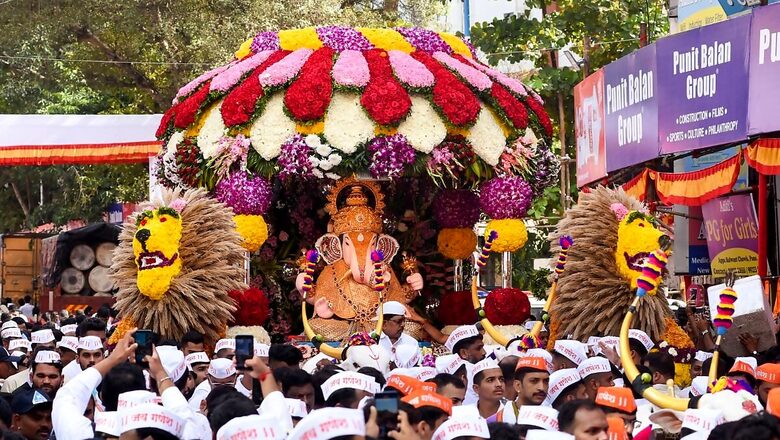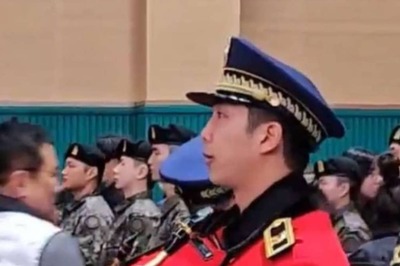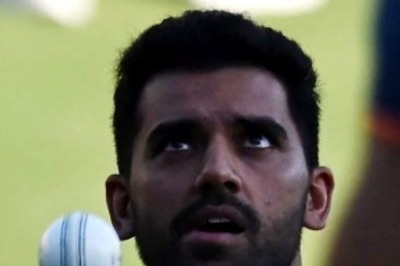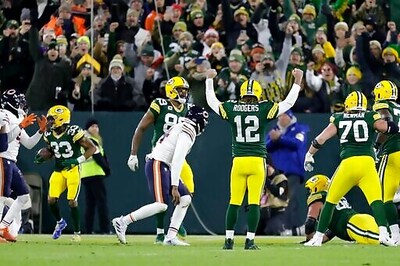
views
Politics is winning over culture. It’s a peeve. It is a strange peeve to have. It comes up essentially during a year marked by a bitterly fought and long election — when the sense of Hindu unity, which 10 years ago might have seemed too distant a phenomenon in India’s cultural prism — was within reach by January, but eluded its sole conscious purpose by May.
It is the year of politics telling culture that a temple built after five centuries is not enough to unite. It is the year when Hindus in another country outside India have discovered deceitful dimensions of a “culture” they were served by politics and were complying with for survival.
It is also the year when politics is hollering at Indic culture, compelling it to buy and believe the idea that it has to break the cast of Hindu identity and see itself in and as caste. The good has failed to unite. The bad has failed to unite. But, unite we must.
If this doesn’t unite Hindus, then what will – it is a question that unfolds and ripples itself on social media narrative like a Mexican wave at a stadium every time the sport of politics shuffles up green and red cards. The answer to this question: combining the utsavs and the finest devotional music dedicated to Ganesha, in the twin abode of Carnatic music, the kritis of Swami Tayagaraja, Muthuswami Dikshitar and Shyama Shastri, as well as Hindustani music. The answer is: Guru Adi Shankaracharya’s Pancharatnam stotra.
The mutating power of a mass movement based on Ganeshotsav’s pan-India propagation through Indian classical music has remained an idea as distant to politics as unity has to the Hindu cause. It must arrive, and arrive before it is too late.
Great classical compositions identifiable with Ganesha devotion
For more than seven decades after Independence, politics has failed to build over the existing movement called Ganeshotsav — a bastion of the kritis, swarjatis and bhajans of the greatest composers preserved in the ragas. These have the power to flip both.
They have become identifiable with Ganesha and devotion to Hindu deity. They can bend latitudes and leap across longitudes. They can elevate the masses.
They can raise the quality of acceptance in the broad acceptance of music by Indian masses. They can rejuvenate Ganesh pandals. They can unite like none other. Simply because they are the timeless matter that cements each brick of each and every temple and temple life, and because Ganesha’s is the only mass utsav emerging from politics.
Ragas such as ‘Gowla’, ‘Begada’, ‘Kedar’, ‘Bageshri’, ‘Hamsadhwani’, ‘Kankangi’, ‘Shankarabharanam’ among others have provided the different hues to the performance of the compositions. They drape the monumental absolutes in creation in devotion to Ganesha.
With unifying and unity as goals, Ganesha Pancharatnam stotra composed by Adi Shankaracharya and its musicality should have travelled across Bharat on the timeless vehicle of the Ganeshotsav – at least in the last 10 years. Tyagaraja’s ‘Sri Gananatham’ and raga ‘Kankangi’ residing in it, need a pilgrimage led by artistes Ranjani and Gayatri for the masses across this sacred land.
Pandit Venkatesh Kumar’s rendition of ‘Gajamukhane Siddhidayakane’ should have travelled from the geography he belongs, to the musical geography celebrated in his art and cover miles beyond toward the Northeast. Each of these compositions is a creative miracle made possible in Ganesha-bhakti.
Pandit Kishan Maharaj composing the Ganesh Paran and a sculpture of Ganesha is a creative miracle. Pandit Birju Maharaj offering the Ganesh Paran as an ‘ahavahan’ — an invocation — in a ritualistic beginning to his performance is miracle.
Keeping the classics away from the masses is by design and construct, intellectual snobbery. Activist-musicians who bleat “music has no barriers” themselves would mind the finest devotional music coming from temples.
Building national integration in a tribute to the creative purpose of devotee artistes isn’t a thing meant for 1980s’ Doordarshan or the responsibility of Ganpati pandals in Maharashtra. It is a landmark event waiting happen during Ganeshotsav and galvanise a sense of temple-life and utsav-based unity.
Somehow, politics is unable to grasp the issue. The reason perhaps is that politics, in its toxic demeanour, responses and riders, is eroding the very basis on which culture prospers, resists attacks on itself, and proclaims the synthesis of those who sincerely preserve and propagate it.
Another possible answer is that the idea of ‘unity’, too, is largely political in countenance. While there are aspects of culture that will help the idea of political unity, politics itself is failing at sculpting unity through culture.
More importantly, today, the byproducts of politics are failing to think “creation” — unlike the times of and unlike Lokmanya Bal Gangadhar Tilak. Politicians today are seemingly failing at creating potent cultural patronage around Ganeshotsav.
The importance of dhol tasha pathaks
On Ganesh Chaturthi, a brilliant, reassuring and relieving news this year is about ‘Shikhandi’ — Maharashtra’s first dhol tasha pathak with transgender members, making its debut in Pune. Members of the transgender community from ‘Shikhandi’ told the media that the propelling factor behind the ‘pathak’ was to elevate their own community’s pride by doing “something meaningful”.
Reports state that the ‘pathak’ will perform at some prominent pandals in Pune. This development is in complete alignment with the vision of Laxmi Narayan Tripathi, who told this author in 2017: “We, the Hindus, are a society where members of the third gender have the status of demigod. Today, I feel that we need to go back to our roots.”
Tripathi describes ‘kinnaras’ as “mangala mukhi” (bearing mouths, words and presence auspicious). This is exciting news for the following reasons.
First, a tradition started in 1893 – for dharma and rashtra – has seen ‘inclusion’ building up in the mass celebration of Ganesha and Ganeshotsav — on real terms and, on Indic terms.
Second, the transgender community has literally created this opportunity on its own – with some help from another ‘pathak’. This is a double victory for the Hindu cause and the celebration of Ganesha and is bound to encourage kinnaras in other cities.
Third, dhol tasha pathaks, since the rejuvenation of the Kedarnath temple (in Rudraprayag), the building of the Mahakal Mahalok (in Ujjain) and the building of the Ram Mandir (in Ayodhya), have helped spread the laya-nuances and the music preserved in the dhol tasha pathaks of Maharashtra, in other states. Dhol tasha pathaks from Maharashtra and Madhya Pradesh have become synonymous with Ganeshotsav. So, any addition or expansion to their music-repertoire is an offering to Ganesha and a win for musical expression associated with the utsav.
Fourth, unity, unity and unity – whether in caste diversity or in gender participation.
Fifth, auspices, utsavs and devotee-strength play a massive role in demolishing the “colonial” and colonial remnants in culture and politics. Transgenders creating their own inclusion in participation through tradition and traditional music, is an inflection point.
Last but not the least, many instruments featured in dhol tasha pathaks are representations of musical instruments, laya and taal as associated with Shiva and Ganesha. Transgenders using those to mark Ganeshotsav is a new chapter in cultural assertion. It is solid social accomplishment in music.
Dhol tasha pathaks may not be counted as the finest and the most subliminal expressions of devotional music, but their political continuity, mass propagation and cultural patronage have contributed to the creation and protection of the finest expressions.
Underestimated are the blessings of cultural assertion that are focused on Ganesha and his many names. In Indian music traditions, the inner being of the devotee-artiste presents music as a ritualistic offering. Each offering counts. Each offering secures the dominance of divine love as the soul of Indian music.
Prime Minister Narendra Modi is aiming for the celebration of a developed India in 2047. However, there is a landmark anniversary in 2043. India will celebrate 150 years of the Lokmanya Bal Gangadhar Tilak.
In 1893, Lokmanya — as the people of the leader was rightly titled — ignited a mass celebration of Ganesh Chaturthi that would mutate as a cultural movement in itself over the next century and beyond. Barely 36 years after the Revolt of 1857 – the first war of Indian Independence – the launching of the mass celebration of Ganeshotsav was done with the sole purpose of uniting and mobilising Hindus against British rule.
The bleeding of Hindu symbolism, devotional fervour, the ritualistic and performative, into the political was done to suffuse the struggle for freedom with the strength of numbers and emotion. As a political leader, Lokmanya was not only able to recognise the strength in mass celebrations offered to Ganesha, but could also use the potency of the devotee’s response to a political cause in a cultural outpouring of pride and resistance.
While leaders who won us freedom from the colonial shackles cannot be retrieved from the pages of history, their vision can be used as inspiration or simply replicated for a geographical expansion of the mass utsav of Ganesha. The difference: back in 1893, Lokmanya’s idea was rooted in bringing the celebration of Ganesha from homes to the public and streets and, this time, it would be from home-base Maharashtra and parts of Madhya Pradesh, to other states.
The devotee-artiste in Indian music, and devotional music for Ganeshotsav
The greatest medium and means to a redux would be Hindustani and Carnatic music and renditions to Ganesha. Many hesitate to acknowledge a facet of ‘Indian music’ or do not want to identify for political reasons.
It is: the greatest composers and luminous maestros who have performed those precious compositions, are themselves ardent devotees. Their first response to the deity through their art is that of darshan – the glance and glimpse of the sacred.
Their art itself is worship and becomes an act in worship. Every aspect of performance is poured out in trickles and flowing volumes to the deity’s feet.
Kathak maestro Pandit Deepak Maharaj told this writer: “Pandit Birju Maharaj made us aware that any offering made to Ganesha in Kathak would be in a simple offering, in the form of worship, invocation, and would not be ostentatious. It had to be in harmony with the ‘chhavi’ of Ganesha, his demeanour, his stance. He is not Krishna.”
In her singing of Vinayagar Agaval, where descriptions of Ganesha’s divinity meet sacred poetry, MS Subbulakshmi delivers a contemplative yet serene exploration of poet-saint Avvaiyar’s devotional poetry dedicated to the deity. As her voice beads in each word in the “song” for Ganesha in absorbed introspection, the listener gets to experience a twinning of purpose, which is, the entwining of the vocalist’s own tribute to the work as well as her sacred offering to Ganesha.
The oceanic expanse of the ‘charanam’ in Muthuswami Dikshitar’s immersive offering to Ganesha ‘Shri Mahaganapati Ravatu’ won’t have reached us without Subbulakshmi’s willing surrender to the swaras ‘Ri’ (Re), Pa and Sa. There is duality in the offering of the singularity inherent in devotion. It comes to the devotee-artiste once in a century.
Devotion creates its own destiny in art. Well-known composers from Karanataka, Professor H Yoganarasimham and Subbulakshmi, were destined to live in the same century. His composition ‘Ekadantam Upasmahe’ would be known for the ages for the endearing quality it celebrates in the Pallavi.
In the Pallavi, Yoganarasimham’s philosophical juxtaposition of the words ‘Ekadantam’ (as Ganesha is described), ‘Ankedantam’ (Ganesha as the giver of many aspects) and Parvatisutam (Parvati’s son) reveals the measured spontaneity when composing for Ganesha.
Today, ‘Hamsadhvani’ is a widely performed raga but if one was to pick one composition where it takes its complete form in a non-pompous, pristine, simple, avatar, it has to be Subbulakshmi’s singing of Ramalinga Swamy’s composition ‘Kalai Nirai Ganapati’. The raga sees its tender character sprawling across the refrain of ‘Charanam Sharanam’.
The worship-verve in the composition flows out like a gentle spring over the whetted edges of technique in singing of the phrase ‘Charanam Sharanam’. The transition from the ritualistic element in her singing of ‘Ganesh Pancharatnam’, ‘Vinayakar Avagal’ and ‘Sri Managanapti’ to the ceremonious ebullience and roundedness felt in her offering of ‘Vathapi Ganapatim’ and ‘Mudhakaratha Mokadakam’, give a close view of human dimensions that musicians encounter in their own understanding of the relatable, the worldly, the transcendent, the conscious and beyond conscious.
To Pandit Jasraj belonged the creation of a raga-dominated oeuvre in the celebrating of Ganesha. His was the unrestrained language of grandeur — the ‘bhavya’ and ‘divya’. If he was assigned the task of celebrating the Ganesh Sahasranama, the names would rush towards him, wanting to be draped and addressed in a raga by him.
But, that alone was not his strength. Pandit Jasraj — the master of moulding ragas into a familial bond with the subject. A case in point is a composition set to Raag Kedar where Ganesha is addressed as ‘Suta Mahesh’ — the son of Shiva.
The magnificent calibre of this captivating composition resides in the choice of a raga. It is popularly picked for celebrating Shiva. Ganesha as the recipient of devotion through a raga assigned (in the performative aspect) to his father, firms up the familial bond between the father and son.
Here, Kedar gets transposed not as musical allegiance between father and son but appears almost like it has been passed over as inheritance. The heady sweetness in Pandit Jasraj’s singing of the antara (stanza) in Ganesha’s praise is overwhelming and overbearing at times in this composition — if left to him alone.
The refrain of ‘Charanam Sharanam’ is that of the composer and the vocalist who is presenting that composition in the moments that make that the glance from the devotee to the deity and from the deity to the devotee go on to sculpt the musical offering and gradually the body of work of the artiste.
In Ganesha Sahasranama, Ganesha himself is ‘naad’. Ganesha himself is ‘laya’. The transcendental terrains between ‘naad’, ‘Brahma’, ‘srishti’, ‘sitithi’ and ‘laya’ are a subject of deep musical explorations that are impossible to achieve even in the paint and brush of expression. Yet, musicians and vocalists from Carnatic and Hindustani tradition have charted through those creative spaces successfully.
The practice of art through this guiding factor defines Carnatic music. This aspect inherent to Carnatic music has preserved the intrinsic beauty of the essence of devotee-composer’s darshan.
The laborious journey of the greatest vocalists in preserving the devotional gives the magnificently distinct identity to Indian music as being naturally, proudly and essentially devotional. The artiste’s process to achieve the expression, form and technique to be able to offer her best in the art, itself is considered pilgrimage.
Just as each pilgrimage poses its own challenges, gusty rivers, and mighty heights and depths to ponder and navigate through, the devotee-artiste’s journey through the ragas offered to the devas, brings its own quests. The devotee artiste’s performative ethos relies on considering art as a “blessing” and “gift” from Saraswati and Matangi.
Devotion or lack of it will define journeys in music. The most vital is the journey to unity resting on the utsav for Gajakarna (the one with the ears of an elephant). It would be the only and the finest tribute to the creative purpose of Lokmanya Bal Gangadhar Tilak and the devotee musicians.
(Views expressed in the above piece are personal and solely those of the author. They do not necessarily reflect News18’s views)



















Comments
0 comment